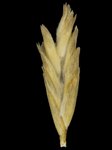
T. mallota spikelet.
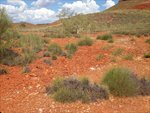
T. mallota habitat.
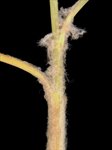
T. mallota orifice and sheath.
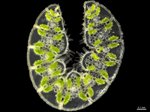
T. mallota leaf section.

T. mallota inflorescence (a spike).

T. mallota glume.
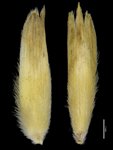
T. mallota lemmas.
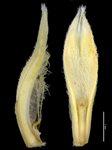
T. mallota paleas.
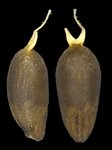
T. mallota caryopses.

T. mallota map.
Name
Triodia mallota B.M.Anderson & M.D.Barrett, ined.
Citation
Austral. Syst. Bot., in press, (2017)
Derivation
mallota — from the Greek mallotos (fleecy, woolly) in reference to the woolly indumentum on the leaf sheaths and orifices.Common name
Pannawonica Woolly Spinifex
Synonyms
Triodia sp. Pannawonica (B.M. Anderson & M.D. Barrett BMA 89Diagnostic features
Foliage non-resinous; leaves amphistomatous (hard-type); orifice and sheaths densely woolly; inflorescence unbranched; pedicels 1–2 mm long; lower glume 9–14-nerved; lemma shortly 3-lobed, indurated for most of its length, not bitextured; lowest lemma midlobe 0.2–1.8 mm long; only known from rocky metasandstone/chert slopes near Pannawonica in the west Pilbara
Habitat
Occurs on rocky hillslopes that are a mixture of metasandstone and chert, and is not known from the pisolite mesas that are the dominant rocky substrates in the area.
Distribution and frequency
Endemic to the Pilbara, where it is known only from a single small population near Pannawonica.
Similar species
A member of the Basedowii group, sharing the group features of non-resinous foliage, amphistomatous (hard-type) leaf blades and many-nerved (≥6) glumes. Only two other members of the Basedowii group (T. infesta and T. plurinervata) share the unbranched inflorescence and short pedicels 1–2 mm long; both species have glabrous to loosely hairy leaf sheaths and orifices (densely woolly in T. mallota), leaf blades <10 cm long (7–18.5 cm in T. mallota), and occur to the south-west or east of the Pilbara.
Triodia spicata also has an unbranched inflorescence and short pedicels, but has 1–3-nerved glumes, glabrous leaf sheaths, and a distribution east of the Pilbara.
Conservation status
Priority One.
Identification without florets
The features above apply in the absence of florets.
Variation
A uniform species as currently known.
Notes
Triodia mallota was not represented in Lazarides (1997), Lazarides et al. (2005) or Ausgrass (Sharp & Simon, 2002; Simon & Alonso, 2014).
A full description of T. mallota can be found in Anderson et al. (2017a).
The single known population appears to have reduced genetic variation compared to other Triodia species (Anderson et al. 2017b).